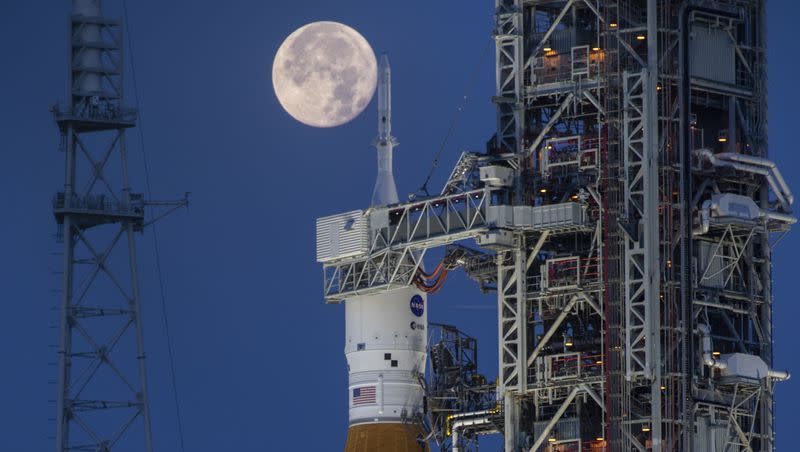Spacesuits, SpaceX, safety worries push NASA to delay moon missions

In a move foreshadowed by federal auditors’ findings late last year, NASA announced Tuesday it was pushing out next steps in its multiphase Artemis moonshot program with two crewed mission launch dates, one aiming to orbit the moon and the other hoping to put astronauts on the lunar surface, each bumped out by one year.
NASA officials said further work to ensure mission safety is driving the rescheduling, as well as delays in third-party programs that are developing new spacesuits, orbital refueling systems and lunar landing spacecraft.
NASA Administrator Bill Nelson announced the Artemis II mission, slated to carry astronauts on a journey that will include orbiting the moon, is now scheduled for launch in September 2025. The Artemis III mission, which will return astronauts to the surface of the moon for the first time in over 50 years, now has a September 2026 target launch date.
Nelson noted the success of the Artemis I mission in late 2022 that included the launch of the new, massive Space Launch System rocket and a 25-day journey for the unmanned Orion crew capsule, which splashed down in the Pacific on Dec. 14 that year after traveling nearly 1.4 million miles.
Related
This Utah author’s work was headed to the moon. Now it’s on a deeper journey
NASA’s plan to return astronauts to the moon falling behind schedule according to new audit
Orion capsule back after 25-day journey as NASA inches closer to moon landing
Artemis I was just the first step in a program aiming to not just put astronauts back on the moon, but to establish a base station there and develop systems to use the Earth’s sole satellite as a launch site for, ultimately, sending human explorers to Mars.
“We’re in a golden era of exploration,” Nelson said at a NASA press conference Monday. “Everyone is excited. This time we’re going back to the moon in order to be able to learn, to live, to create and invent in order that we can eventually go to Mars.”
Amit Kshatriya, deputy associate administrator of Exploration Systems Development and manager of NASA’s Moon to Mars Program Office, outlined some of the issues that are contributing to schedule delays, including data gathered from the returned Orion crew capsule that showed some unexpected wear and tear on the heat shield material that protects astronauts during reentry to Earth’s atmosphere, when temperatures can hit 5,000 degrees.
“Artemis is a long-term exploration campaign to conduct science at the moon with astronauts and prepare for future human missions to Mars,” Kshatriya said. “That means we must get it right as we develop and fly our foundational systems so that we can safely carry out these missions.
“Crew safety is and will remain our No. 1 priority.”
Kshatriya also noted the work to develop new spacesuits by NASA contractee Houston-based Axiom Space, and orbital refueling and lunar landing systems that Elon Musk-owned SpaceX is developing, is moving slower than expected, contributing to the need for additional time before the next Artemis program launches.
The lag in Artemis-related work being performed by Axiom and SpaceX was also highlighted in a November report from the U.S. Government Accountability Office.
GAO analysts found that while NASA and its contractors had made progress since the auditing body’s last report in September 2022, “they still face multiple challenges with development of the human landing system and the space suits.” Auditors also noted failures in recent attempts at orbital tests of the SpaceX Starship rocket system slated to power NASA astronauts’ return to the moon are also contributing to extended timelines.
The report underscored that NASA may have erred early on in its estimation of timelines for the planned advancements in the Artemis program, calculating shorter development windows than the agency has used in the past for less complicated projects.
“The complexity of human spaceflight suggests that it is unrealistic to expect the program to complete development more than a year faster than the average for NASA major projects, the majority of which are not human spaceflight projects,” the report reads. “GAO found that if development took as long as the average for NASA major projects, the Artemis III mission would likely occur in early 2027.”
Auditors also noted that NASA is making unprecedented use of third-party contractors to reach the goals established for the different phases of the Artemis program.
“To accomplish the Artemis III mission as planned by December 2025, NASA needs to develop, acquire, and integrate several new systems,” the report reads. “These include a system to transport crew to and from the lunar surface, and space suits for lunar surface operations. NASA is using a relatively new approach to acquire the human landing system and space suits that is intended to increase innovation and improve affordability.”
Besides the human landing system that will transport astronauts from lunar orbit to the surface of the moon, SpaceX is also tasked with the development of a system to launch multiple tankers that will transfer propellant to a depot in space before transferring that propellant to the human landing system. Per the GAO report, NASA documentation states that SpaceX has made limited progress “maturing the technologies needed to support this aspect of its plan.”
While the first two SpaceX launches of its Starship Rocket system, which will power the future missions for the Artemis missions’ orbital refueling needs, have ended in explosions, SpaceX executive Jessica Jensen said Tuesday a third launch attempt is likely in February.

